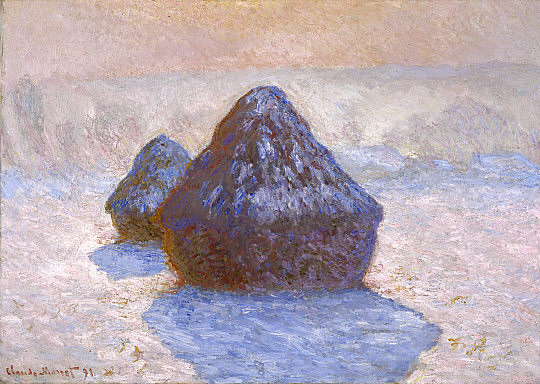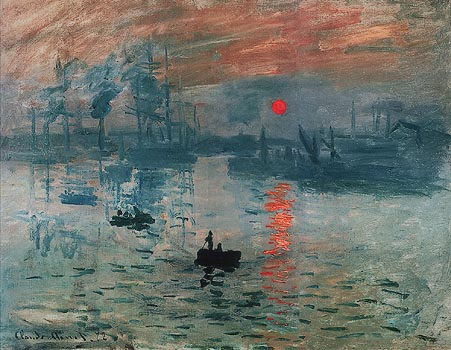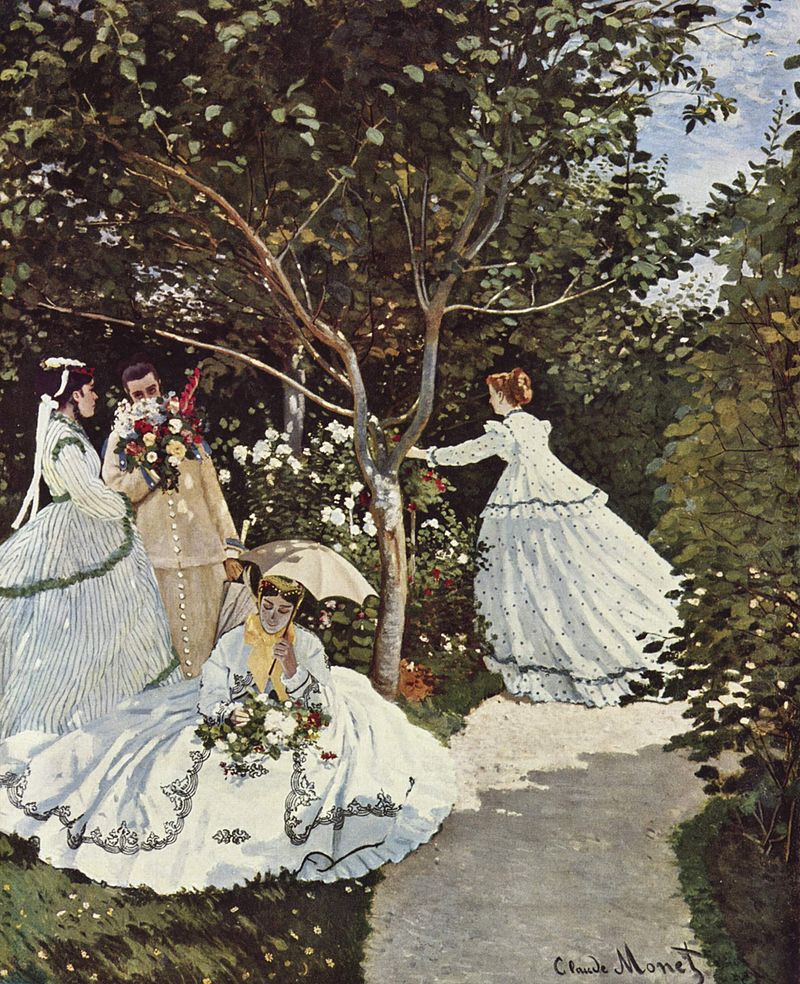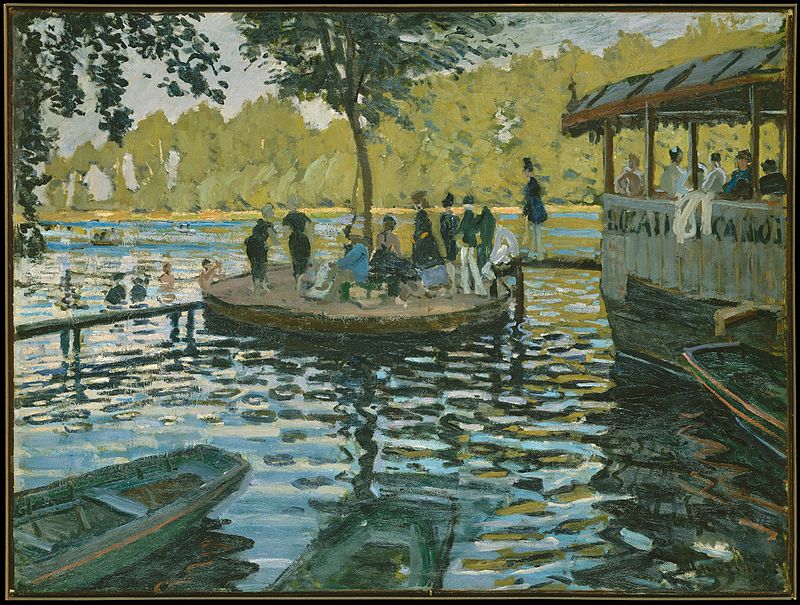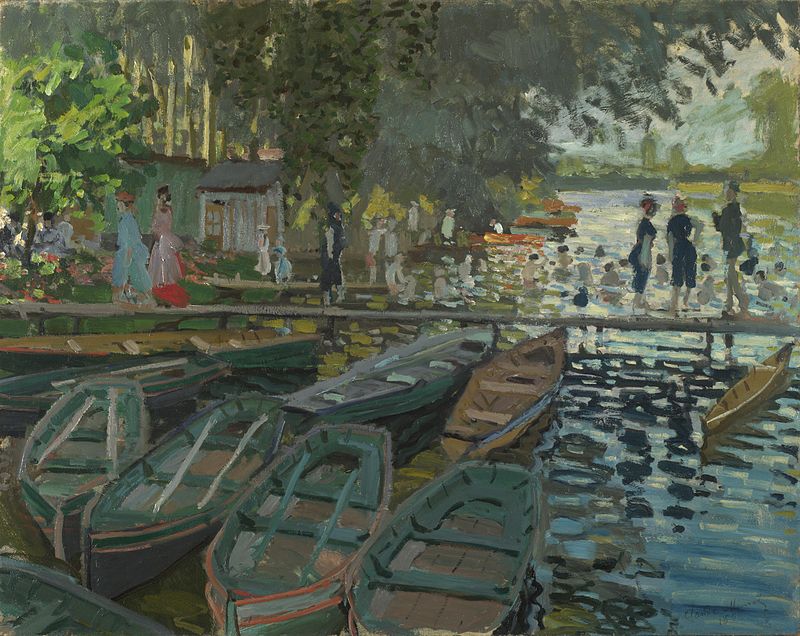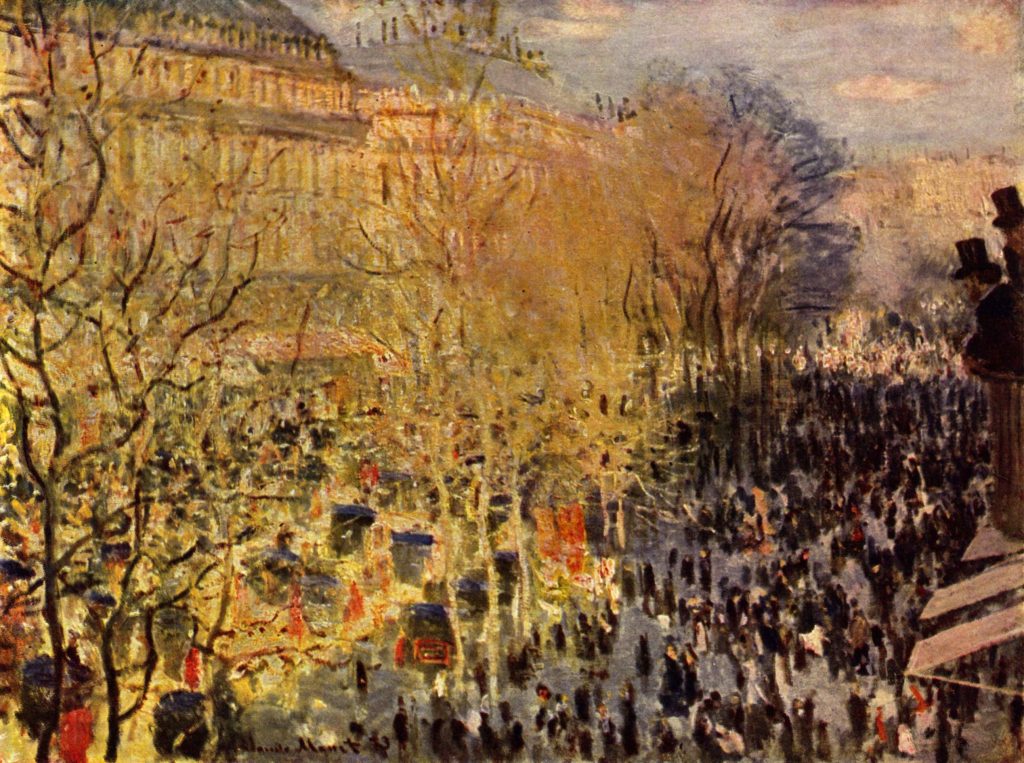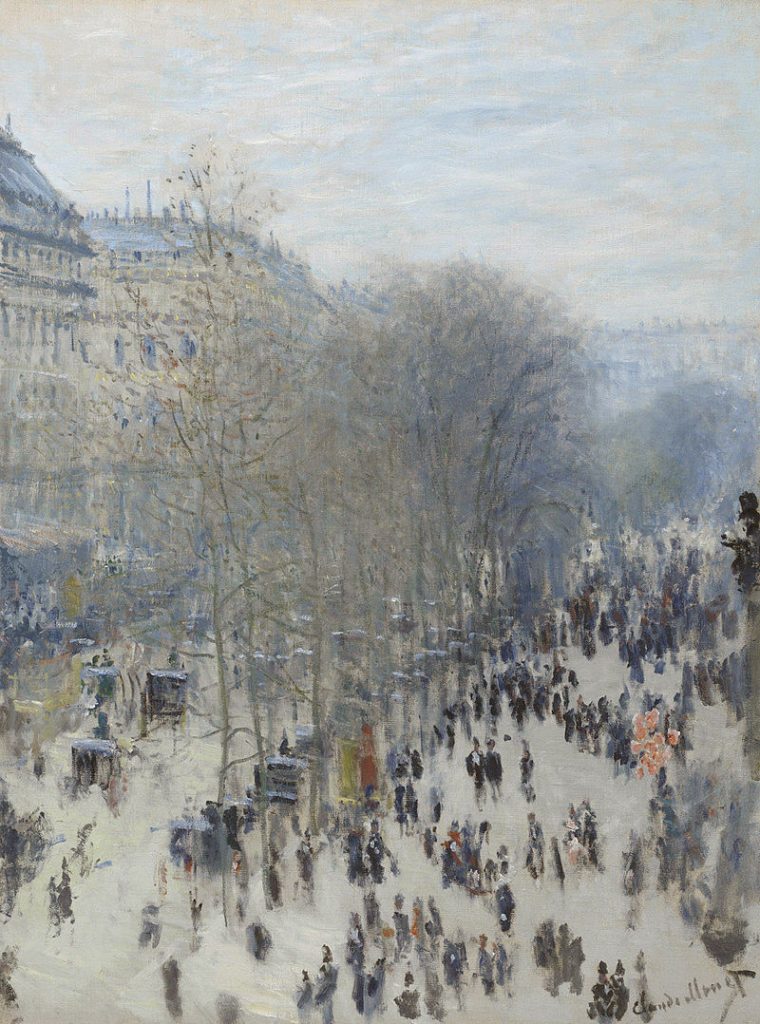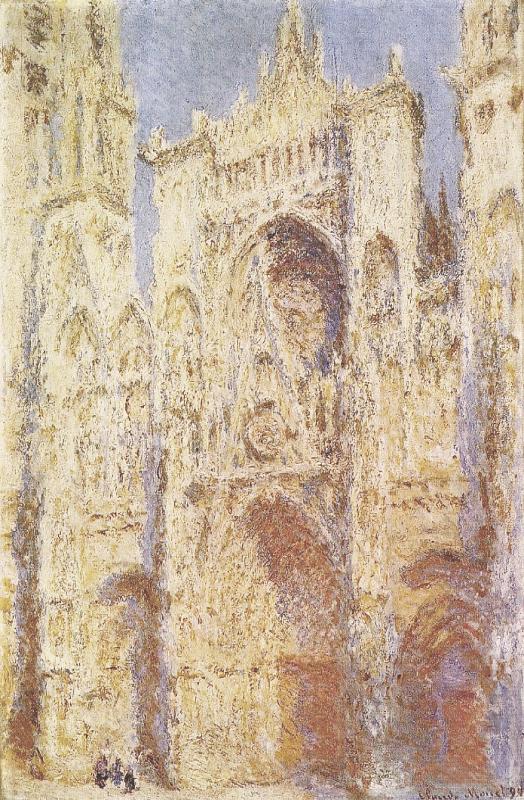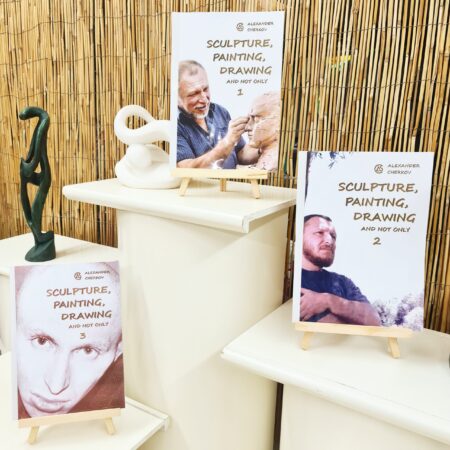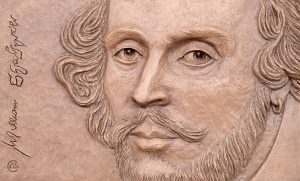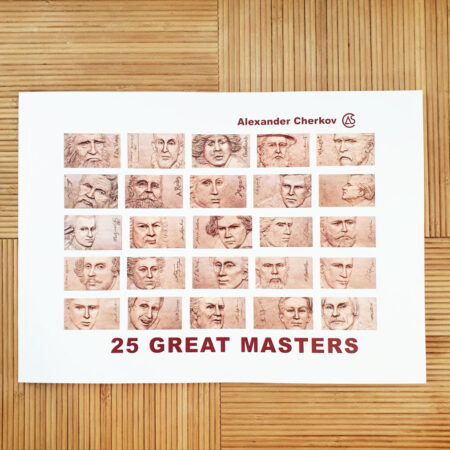The artist Claude Monet (1840-1926), was a French painter, one of the leaders and founders of the Impressionist movement. Mona painted mainly landscape paintings depicting the variability of color and material in relation to the variability of light, at different times and in different weather.
The artist Claude Monet does not paint the landscape clearly but short brushstrokes. This is a relatively small painting. Monet painted the waves with short black brushstrokes and the boats are a black stain. The farther boat is smaller. The whole landscape is blurred. You don't notice the actual shape of the trees and the crane (probably it's trees but we're not sure). Monet presents this painting for the first time in 1874 at the first Impressionist exhibition, in a photographer's shop (there are already exhibitions in places other than the Salon of the Louvre). One of the critics really doesn't like the painting. He says that there is nothing in painting but impressions and hence the name Impressionism. Since the members of the salon's visitors reject artists who did not paint exactly according to tradition, the king announces the Salon of the Rejected in 1863, and then the Salon of the Independents is established in 1883. There has been an important change in terms of the display location. There is an alternative place to display the photos. The first Impressionist exhibition is not shown in the living room.
Before drawing the painting of the rising sun he draws other paintings that lead him to this blurring.
This is a much larger painting than the Rising Sun painting. Sunny painting. People who enjoy a background of leisure in the garden, the women are dressed in white. White has spots of darker colors. A counter paints the change in color as the sun shines on the color. Where the sun is stronger the skirts are whiter, where the shadow is less noticeable the whiteness.
The same thing he does to the tree trunk and the sun that plays with the foliage (the tree leaves). The tree is not one block, we notice leaves. Some are bright because the sun is shining on them and others are dark because they are in the shade. Counter considerate lighting. He did paint the painting the painting in the open air. He dug a hole in the ground so he could lower the painting on wheels and work on the top (the painting is 255 inches high). He did not finish the painting outside, but he examined the fall of light on every part of the painting. This interest is seen when we compare to earlier paintings:
Claude Lorraine also paints people in the landscape but if we look at the trees it seems that for him the head of the tree is a kind of mass. Claude Lorraine did not paint the lighting, the sun, as it appears in every leaf like a counter. It is possible to understand what was recounted. Mona paints what he sees in sunlight, how the sun changes colors and texture. At Claude Lorraine one notices immediately. Certainly Claude Lorraine practically paints in oil on canvas. But it gives the illusion that the canvas does not exist, and that we are looking at a view before our eyes. The fabric is transparent.
Mona paints the women in the garden differently than they also painted in the early 19th century.
Constable painted mostly a landscape, a simple landscape of England. One can see the difference between Constable's foliage and Monet's since eight painted some of the painting outside and was aware of what he was seeing.
Afterwards, the artist Claude Monet paints with the other Impressionist artists the Seine. Bathing in Guerra Neuer. It is an agricultural village on the river bank where the Parisians are numbered, traveling to bathe and spend the weekend. Not only are the colors like eight painted them. When the light is strong we do not notice the quality of the material. In strong light you do not see well that it is a tree.
The light obscures the texture, so here we see that the boats do not notice that they are wood, it looks like a brown spot since the strong sun eats away at its appearance. Three years after Women in the Garden Counter changes the painting according to the lighting to a greater extent. The women look like a black spot. We do not know what the huts are made of. We are very far from the Inger paintings we saw in the previous lesson in which we noticed the characteristics of each item. In Mona everything becomes stains of color. It's not as smooth as with David or Inger.
They drove to the same place and drew the same thing. They both do not notice that the boat is made of wood. Do not see the texture of the wood. We notice something brown happening to a boat and the characters turn into spots because the sun is shining on them. The color and texture is influenced by light.
The other influence is of the city.
Renoir paints the Pont Neff which is the "new bridge" in the Seine in Paris. And Mona paints the train station whose name is Saint-Lazare-St. Lazar (the first train station in central Paris) from which they traveled to the villages. In Mona he draws the effect of light but also the effect of space in general and the effect of steam, what the objects look like. The structure when the locomotive enters and the steam exits.
In the center there is a stronger light then the colors, some light and some darker because the right part of the locomotive is stronger light while the left part is more in the shade. In the painting of the bridge, the figures are not clear. It is the city under the sun, the visibility is not sharp.
The city again in a painting by Mona called Caposin Boulevard. After the impression the sun rises and after the Grand Noir Avenue in the city. Mona and his friend are standing on the porch. Some in the shade and some in the light. The brush ointments are wide. This is not a drawing but a work with the brush and the flickering light moves from place to place. The crowds that pass through the street are patches of paint. Mona looks up at the street from above.
Following the filming, Nader was a photographer. One of the first photographers and we have a cartoon about him. He's on a balloon and he's over town. Silence calls painting a vow lifts the photograph (it is indeed elevated) and it also elevates the photography to the level of art. The exhibition was done in Nader's studio, and as Nader did photograph Paris from above from the balloon, Mona paints the avenue from the balcony railing. The revelation before his eyes and when he stands from above the people look like spots and because they are moving he does not draw them clear.
So we saw two issues. One was in nature, and the city.
A brief overview of the history of France in the 19th century:
We know there was a revolution in the late 18th century and then Napoleon makes himself king, but Napoleon is pus. After the Revolution, the kings are killed and the first republic is established but Napoleon declares himself an empire and a king of 1804-14 when Napoleon is expelled returns to the royal house of France (Bourbon) and there are two kings Louis XV who died a natural death and then came to power 18 years then the French were fed up with it- they did not want it anymore and then there was the July Revolution in 10. The most famous painting of the revolution.
After the July Revolution Louis Philippe came to power who is also from the royal family and is in front of you until 1848. After 18 years, the French are fed up with Louis Philippe so there is another revolution, of February. The royal house is over and the Second Republic is declared. The President of the Republic is a nephew of Napoleon. But he was president until the end of 1851 (3 years) he had to leave because according to the constitution he could not be president for more than 3 years. He did not like it so he dispersed the House of Representatives and the king himself. Since then his name is Napoleon III. He restored the monarchy.
There are many revolutions, people take to the streets but things do not change. Napoleon III's great enterprise: his police minister was Baron Hausman, he appointed Baron Hausman to change the face of the city. All of Paris until the second half of the 3th century had narrow, curving streets, courtyards. The trade was inside the yard, not across the street. The shops were inside the yards. Louis Napoleon decides to take down all the buildings, take out in the West Bank all the poor who just get dirty and instead of all the winding streets with the old houses, pave a long boulevard that runs along Paris (one part is called Capuchin Avenue) and build new buildings along the boulevards. They are all the same - 19 floors. Ground floor across the sidewalk, shops. And above them 5-4 floors and an attic. All the buildings are the same color - brown is obscured, and the attic is gray (for the maids) and a wide boulevard.
The shops then are no longer hidden in musty courtyards but spacious shops along the street. And a wide boulevard with a wide road. Then you can wander the street. The wide boulevards allow control over what happens. In 1848 during the revolutions the demonstrators were able to hide in the courtyards, uproot the stones and the army had a hard time advancing through winding and narrow streets. In the wide boulevard it is possible to move policemen on horseback and disperse the demonstration. Louis Napoleon takes control of the city. This is a very authoritarian rule and there is a restriction of individual liberties. But it gives freedom of trade and consumption. This is the first consumer company. So the change is very significant.
We see people wandering the street, a wide sidewalk, there can be a lot of people. Once again an observer was appointed from above. The new houses appear along the boulevard. The light flickering in the trees on the buildings is equivalent to the moving people. Mona's technique is not without significance because the technique of small color dots, of flicker, of spots is equivalent to the passing mass, to the new mobility. The possibility of movement on two levels. But also the possibility of class leadership movement - it is possible to rise in class. Class mobility or in fact the end of class fixation as we have seen in Mana's Olympia. In Olympia we do not know its status. Trade is booming. At the same time the beginning of the big stores. The first consumer company when building a store due to La Bon Marca (meaning the name of the store - a good deal) - a department store that opened as a small store in 1838 and grew in 1850 and expanded again in 1920. In any case, we understand that what matters is money. The people in Mona's painting are consumers, they consume. And appointed in the technique of painting and on the subject he paints the new bourgeois, the new fellow of the city-center from which the poor were expelled. The freedom of the individual to consume when in fact all other aspects of life is under constant supervision.
Artist Claude was appointed a partner in this joy of social leadership through art, he came from a lower class.
Since the painting is no longer about a text but a construction of a painting, the subject does not matter. Certainly not in the case of these paintings by Mona. He can draw haystacks over and over again. He paints the haystacks at different times of the day. Mona wants to examine how we see the world, how our physiological eye sees something else slightly different in the morning and at noon. The sun falls in a different way, it is stronger and stronger less the light shines more brighter less and then our distinction is different in the same thing. He examines the relationship between lighting and color and material. The different colors that objects get because of one lighting or another. Also in different weather
Artist Claude Mona painted the changing of light in different seasons. As he paints the haystacks he paints trees:
In 1891 a poplar tree painter was appointed, again in different seasons. To see the different relationships between light and color.
In 1894 he painted Rowan Cathedral. Again, at sunset. in the morning. We do not notice stones - the sun eats the material.
There are more pictures of the cathedral in different weather, different hours. Artist Claude has been appointed an expert on the same relationship.

